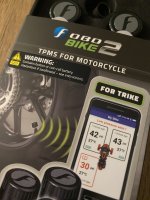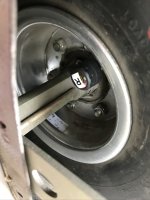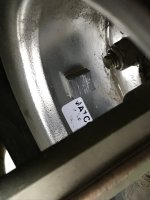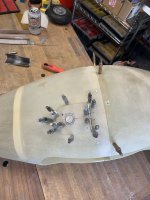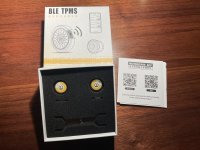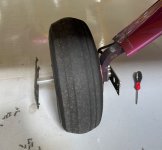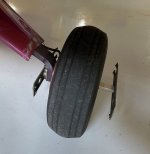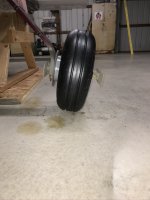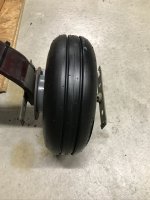Van's Air Force
You are using an out of date browser. It may not display this or other websites correctly.
You should upgrade or use an alternative browser.
You should upgrade or use an alternative browser.
Tyre pressure tolerance
- Thread starter magiccarpet
- Start date
I don't have an answer to your actual question, but I am very curious about using tire pressure monitors on an RV. Do they work? Do they affect tire balance? If they work I think it would be a great addition because checking tire pressure is a pain, even with an access hole in the wheel pants.
Any info would be appreciated.
thanks
Ivan
Any info would be appreciated.
thanks
Ivan
I think the TPMS monitor is a great idea if balance etc doesn't become a problem. Taking the wheel pants off to check tire pressure can be such a pain.
However, I think those minimum values you mentioned (22 / 25 psi) are way too low. I sold my 7A last year, but a few years ago I had some pretty significant wheel pant damage due to low tire pressure on the mains and those pressures were in the low 40s at the time of the problem. So I recommend something much higher. Just my $.02.
Matt McManus
However, I think those minimum values you mentioned (22 / 25 psi) are way too low. I sold my 7A last year, but a few years ago I had some pretty significant wheel pant damage due to low tire pressure on the mains and those pressures were in the low 40s at the time of the problem. So I recommend something much higher. Just my $.02.
Matt McManus
I think the TPMS monitor is a great idea if balance etc doesn't become a problem. Taking the wheel pants off to check tire pressure can be such a pain.
However, I think those minimum values you mentioned (22 / 25 psi) are way too low. I sold my 7A last year, but a few years ago I had some pretty significant wheel pant damage due to low tire pressure on the mains and those pressures were in the low 40s at the time of the problem. So I recommend something much higher. Just my $.02.
Matt McManus
The POH lists the "optimum" tire pressures at 22 front and 25 mains with 23 and 28 being the "maximum" respectively. I'd go with the POH.I don't have an answer to your actual question, but I am very curious about using tire pressure monitors on an RV. Do they work? Do they affect tire balance? If they work I think it would be a great addition because checking tire pressure is a pain, even with an access hole in the wheel pants.
Any info would be appreciated.
thanks
Ivan
Piper J3
Well Known Member
I installed TPM’s on my RV-12 several years ago, but only on the main wheels. The fork on the nose wheel does not allow clearance for TPM to be installed. I used a ¼ ounce stick-on wheel weight to offset the TPM and balance is uneffected.
That said… I run the TPM app and place cell phone on pilot-side wing walk at beginning of preflight inspection. By the time I have fisnished my walk-around the TPM has registered for both wheels. I then log the readings to plot air loss over time. By setting phone on wing walk… it is almost impossible to forget phone before climbing into cockpit. Not impossible… but close to it.
That said… I run the TPM app and place cell phone on pilot-side wing walk at beginning of preflight inspection. By the time I have fisnished my walk-around the TPM has registered for both wheels. I then log the readings to plot air loss over time. By setting phone on wing walk… it is almost impossible to forget phone before climbing into cockpit. Not impossible… but close to it.
Attachments
Thanks. I'll order a TPMS today!I installed TPM’s on my RV-12 several years ago, but only on the main wheels. The fork on the nose wheel does not allow clearance for TPM to be installed. I used a ¼ ounce stick-on wheel weight to offset the TPM and balance is uneffected.
That said… I run the TPM app and place cell phone on pilot-side wing walk at beginning of preflight inspection. By the time I have fisnished my walk-around the TPM has registered for both wheels. I then log the readings to plot air loss over time. By setting phone on wing walk… it is almost impossible to forget phone before climbing into cockpit. Not impossible… but close to it.
liuk
Active Member
I'm always wondering: does this cap sensor operate by pressing against the Schrader valve to gauge the pressure? If so, does this imply that the thread on the cap is the only thing maintaining the pressure?I installed TPM’s on my RV-12 several years ago, but only on the main wheels. The fork on the nose wheel does not allow clearance for TPM to be installed. I used a ¼ ounce stick-on wheel weight to offset the TPM and balance is uneffected.
That said… I run the TPM app and place cell phone on pilot-side wing walk at beginning of preflight inspection. By the time I have fisnished my walk-around the TPM has registered for both wheels. I then log the readings to plot air loss over time. By setting phone on wing walk… it is almost impossible to forget phone before climbing into cockpit. Not impossible… but close to it.
I believe that‘s exactly the case.I'm always wondering: does this cap sensor operate by pressing against the Schrader valve to gauge the pressure? If so, does this imply that the thread on the cap is the only thing maintaining the pressure?
I plan to the same and will maintain a log to more precisely monitor pressure loss over time.I installed TPM’s on my RV-12 several years ago, but only on the main wheels. The fork on the nose wheel does not allow clearance for TPM to be installed. I used a ¼ ounce stick-on wheel weight to offset the TPM and balance is uneffected.
That said… I run the TPM app and place cell phone on pilot-side wing walk at beginning of preflight inspection. By the time I have fisnished my walk-around the TPM has registered for both wheels. I then log the readings to plot air loss over time. By setting phone on wing walk… it is almost impossible to forget phone before climbing into cockpit. Not impossible… but close to it.
Piper J3
Well Known Member
The TPM has a rubber diaphragm that presses against the schrader valve to hold it open. The rubber diaphragm seals against the end of the brass threaded valve stem. I use a thick silicone grease (dielectric grease) on the face of the diaphragm to maintain the seal.I'm always wondering: does this cap sensor operate by pressing against the Schrader valve to gauge the pressure? If so, does this imply that the thread on the cap is the only thing maintaining the pressure?
I bought a set but don’t need since I built access doors in my wheel pants. Will post in classifieds later today unless some wants them before I post. NIB $25 and shipping on me.
It’s just one thing less to get rid of later
It’s just one thing less to get rid of later
Attachments
I bought a set but don’t need since I built access doors in my wheel pants. Will post in classifieds later today unless some wants them before I post. NIB $25 and shipping on me.
It’s just one thing less to get rid of later
I realize that TPMS wasn’t the original focus of this post. But, in the constantly changing world of electronics, what are people using for TPMS monitoring? What do they like and what do they dislike? What has been learned since using them?
Thanks.
Brett
PilotjohnS
Well Known Member
I am using 40 psi. Add air at 35 psi. (Broke wheel pants too many times)
dmattmul
Well Known Member
Yes, I didn't feel that lucky to use this set-up. 25 psi seems very low. I use 40 psi min and air up to 60 psi. That is what Beringer recommends for the Michelin Aviator.I'm always wondering: does this cap sensor operate by pressing against the Schrader valve to gauge the pressure? If so, does this imply that the thread on the cap is the only thing maintaining the pressure?
It's an optimum (for some) in terms of shimmy reduction. It's far from optimum if you want long inner tube life and fewer wheelpant repairs.The POH lists the "optimum" tire pressures at 22 front and 25 mains with 23 and 28 being the "maximum" respectively. I'd go with the POH.
Piper J3
Well Known Member
I think I remember reading that it has to do with dynamics of the landing gear – softens some the impact forces transferred into the airframe. There are a couple of SB’s to strengthen the landing gear carry-through channel...Any idea why Van’s recommends the lower pressures?
Certainly can’t speak for Van’s, but can’t help but notice how due to the camber of the main gear, that the higher the tire pressure, the more the tire rides on its outer edge. That, plus riding on a smaller area seems that it would accelerate tire wear. And the lighter the plane is loaded, the more pronounced it is. Might not be as bad if operating off grass, but on pavement it seems like it would cause earlier tire wear with higher inflation pressures.Any idea why Van’s recommends the lower pressures?
I think I remember reading that it has to do with dynamics of the landing gear – softens some the impact forces transferred into the airframe. There are a couple of SB’s to strengthen the landing gear carry-through channel...
This is also what I understand to be a reasonable explanation. This is common thinking on light sport designs, landing gear design is unfortunately part of the formula to hit 1320. I personally think of the tires as a consumable part of the landing gear system and would rather live with replacing those than other parts of the structure.
dmattmul
Well Known Member
I know landings are an important criterion but since I don't track these, I got 450 hrs. on my mains then changed and at 550 hrs. nose wheel has at least another 200 hrs. All pavement and my home base 3,500 ft with trees and power lines to contend with. RV-14A. Average about 45 mins per L&TO. Never a shimmy at 40 - 60 psi. Michelon tubeless tires. Did swap and flip the mains at 250 hrs. Solid tone on AOA point of contact with ground or at least goal.Certainly can’t speak for Van’s, but can’t help but notice how due to the camber of the main gear, that the higher the tire pressure, the more the tire rides on its outer edge. That, plus riding on a smaller area seems that it would accelerate tire wear. And the lighter the plane is loaded, the more pronounced it is. Might not be as bad if operating off grass, but on pavement it seems like it would cause earlier tire wear with higher inflation pressures.
Attachments
My bad...I failed to note this thread is in the RV-12 forum. I have no idea why Vans specified the low pressure. However, compared to the 6-7-8-9, the 12's lower gross weight would not mash the tire so much during a sudden arrival.I think I remember reading that it has to do with dynamics of the landing gear – softens some the impact forces transferred into the airframe. There are a couple of SB’s to strengthen the landing gear carry-through channel...
BillL
Well Known Member
I assume they have internal batteries in the sensor? How long before they turn off communication (saving battery mode) if they are not moving? This was an issue some time ago, the plane had to roll to initiate, and in a long flight they would time out and not read for landing.I installed TPM’s on my RV-12 several years ago, but only on the main wheels. The fork on the nose wheel does not allow clearance for TPM to be installed. I used a ¼ ounce stick-on wheel weight to offset the TPM and balance is uneffected.
That said… I run the TPM app and place cell phone on pilot-side wing walk at beginning of preflight inspection. By the time I have fisnished my walk-around the TPM has registered for both wheels. I then log the readings to plot air loss over time. By setting phone on wing walk… it is almost impossible to forget phone before climbing into cockpit. Not impossible… but close to it.
Thanks!!
I just installed a set on my RV7 and want to say thanks to the original poster for giving me the idea. I used the FOBO Bike 2 version, $99 on Amazon. Installation and set up could not have been easier. Remove the front half of the wheel pant, remove the valve stem cap, screw on the TPMS sensor, activate via the app. As a previous poster said, it seals to the top of the valve stem with a rubber gasket. Each sensor weighs 7.6 grams (1/4 OZ). I put a compensating 1/4 OZ stick-on tire weight (also Amazon) opposite the valve stem. Rolled the airplane back and forth to confirm they did not hit anything. The only possible interference might be the cotter pin, if it stuck out unusually far. Mine had plenty of clearance.I assume they have internal batteries in the sensor? How long before they turn off communication (saving battery mode) if they are not moving? This was an issue some time ago, the plane had to roll to initiate, and in a long flight they would time out and not read for landing.
Thanks!!
I'm a very happy customer so far. The sensors immediately read each pressure down to a tenth of a PSI and temperature too. Time will tell about battery life, but comments online suggest that it won't be a problem. It takes the common, cheap CR1632 battery and I plan to add changing them to my annual CI checklist.
Yes, you have to remove the sensors to add air. That's a downside and might be hard to do through a 1" access port. Being able to precisely check the pressure at every prefilght without having to get down on my hands and knees far outweighs having to remove the front half of the wheel pants once in a very long while to add air.
Again, thanks to the original poster for giving me the idea. I am only sorry that I didn't think of this long ago!
As to pressures, I run between 35 and 40 and it seems to work well. There seem to be lots of opinions and little authoritative guidance. My only real data point is that I've landed the airplane 314 times and the tires are still in very good condition (Thanks Foreflight!)
-Ivan
Regarding RV-12 recommended tire pressures….
A lot of people do not know that the tire and its internal pressure is part of the energy absorbing design of a landing gear system .
In an ideal world, the landing gear system would be capable of absorbing all of the energy from a worst case vertical drop, while reducing the vertical descent rate to zero.
Doing so keeps the load induced into the landing gear attachment structure to a minimum.
If the tire pressure is too high, more of the total energy gets transferred to the landing gear leg ( for an example think of a solid steel tire. It would have virtually zero compressibility so all of the vertical load would have to be absorbed by the landing gear leg.).
If the tire pressure is too low, it can be much more easily compressed. If during a particular load event it becomes fully compressed, it from that point acts like a solid steel wheel as in the previous example and transfers all remaining load to the landing gear leg.
This is why using the proper tire pressure on the RV 12 is important.
The lower specified pressures are not an issue for the RV 12 because the gross weight is about the same as the empty weight of all of the other two seat RV models, so the amount of tire compression and resultant tube movement is about the same as for other models.
A lot of people do not know that the tire and its internal pressure is part of the energy absorbing design of a landing gear system .
In an ideal world, the landing gear system would be capable of absorbing all of the energy from a worst case vertical drop, while reducing the vertical descent rate to zero.
Doing so keeps the load induced into the landing gear attachment structure to a minimum.
If the tire pressure is too high, more of the total energy gets transferred to the landing gear leg ( for an example think of a solid steel tire. It would have virtually zero compressibility so all of the vertical load would have to be absorbed by the landing gear leg.).
If the tire pressure is too low, it can be much more easily compressed. If during a particular load event it becomes fully compressed, it from that point acts like a solid steel wheel as in the previous example and transfers all remaining load to the landing gear leg.
This is why using the proper tire pressure on the RV 12 is important.
The lower specified pressures are not an issue for the RV 12 because the gross weight is about the same as the empty weight of all of the other two seat RV models, so the amount of tire compression and resultant tube movement is about the same as for other models.
Piper J3
Well Known Member
Yes, tires wear on outside edge because camber angle is excessive when gear is lightly loaded as when wheels just touch on landing. Tires can be unmounted and flipped on wheels so inside surface can be used before carcass gets tossed.Certainly can’t speak for Van’s, but can’t help but notice how due to the camber of the main gear, that the higher the tire pressure, the more the tire rides on its outer edge. That, plus riding on a smaller area seems that it would accelerate tire wear. And the lighter the plane is loaded, the more pronounced it is. Might not be as bad if operating off grass, but on pavement it seems like it would cause earlier tire wear with higher inflation pressures.
I changed to Desser Tire 500-5 6 PLY AWBS RETREAD ELITE PREMIUM 2 GROOVE (ELITE) which have a a thicker tread at the edges. Wheel pant opening needs slight trim to maintain 1/2" clearance to tire...
Attachments
I am looking for min/max. pressure values in order to setup the warning levels of my TPM BT sensors.
What values do you think are still acceptable before inflating is required.
My nominal value is 22psi for the nose wheel and 25psi for the mains.
Thanks a lot.
Chris
View attachment 57252
Chris:
Out of curiosity, what has been your experience using the FOBO TPMS system? How much clearance do you have between the sensor and the inside of the nose wheel fork?
Thanks.
Brett



